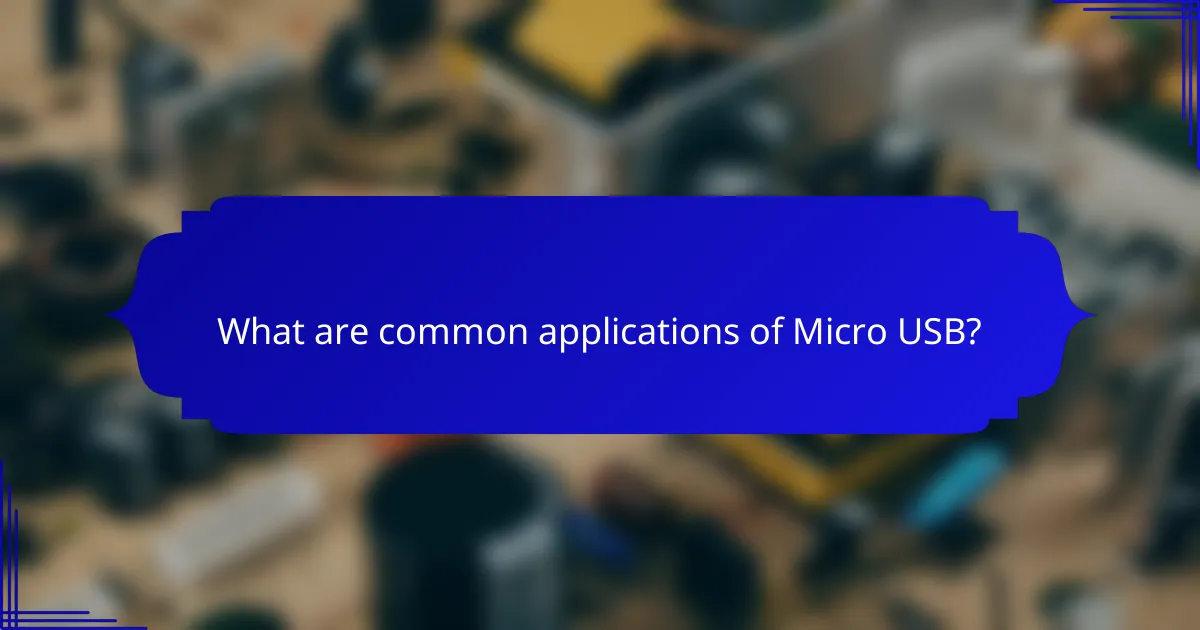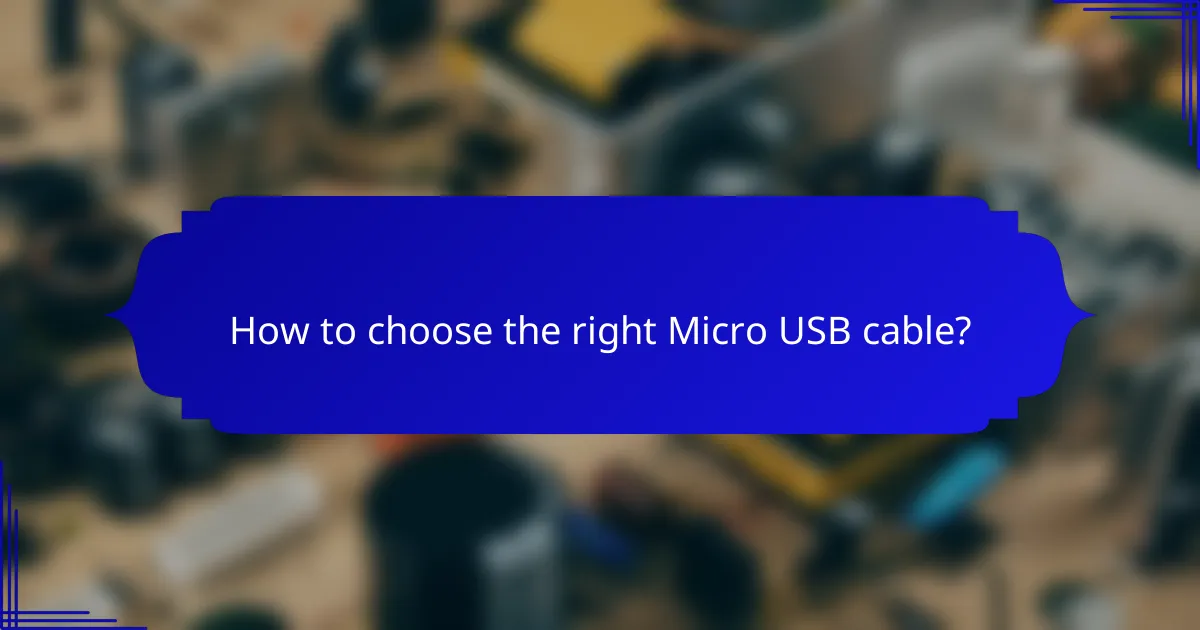Micro USB connectors are known for their compact size and efficient charging capabilities, making them a popular choice for a wide range of devices. They enhance charging efficiency through advanced technology, allowing for faster power transfer and reduced energy loss. Common applications include smartphones, tablets, and portable audio devices, where quick charging and compatibility are essential.

How does Micro USB improve charging efficiency?
Micro USB enhances charging efficiency through its compact design and advanced technology, allowing for faster power transfer and reduced energy loss. This results in quicker charging times and lower energy consumption compared to older standards.
Fast charging capabilities
Micro USB supports fast charging protocols, enabling devices to charge significantly quicker than traditional methods. Many smartphones and tablets equipped with Micro USB can achieve a full charge in under two hours, depending on the charger and device specifications.
To take advantage of fast charging, ensure you use a compatible charger that supports the fast charging feature. Look for chargers labeled with terms like “Quick Charge” or “Fast Charge” to maximize efficiency.
Low power consumption
Micro USB connectors are designed to minimize power loss during charging, making them more energy-efficient. This low power consumption is particularly beneficial for portable devices, extending battery life and reducing electricity costs.
Using a Micro USB charger can lead to energy savings, especially when charging multiple devices. Opt for high-quality cables and chargers to ensure optimal performance and efficiency.
Compatibility with various devices
Micro USB is widely used across a range of devices, including smartphones, tablets, cameras, and other electronics. This universal compatibility means that a single charger can often be used for multiple devices, simplifying charging needs.
When purchasing a Micro USB charger or cable, check for compatibility with your specific devices. Most modern gadgets support this standard, but always verify to avoid issues with charging speeds or connectivity.

What are common applications of Micro USB?
Micro USB connectors are widely used in various devices due to their compact size and efficient charging capabilities. Common applications include smartphones, tablets, wearable technology, and portable audio devices.
Smartphones and tablets
Micro USB is a standard charging and data transfer interface for many smartphones and tablets, especially older models. It allows users to connect their devices to chargers, computers, and other peripherals easily.
When using Micro USB for charging, ensure that the cable and charger are compatible with your device to avoid damage. Most Micro USB chargers provide a charging speed of around 5V and 2A, which is suitable for most smartphones and tablets.
Wearable technology
Many wearable devices, such as fitness trackers and smartwatches, utilize Micro USB for charging. This standardization allows users to charge multiple devices with the same cable, enhancing convenience.
When selecting a Micro USB charger for wearables, consider the power requirements, as some devices may require lower charging currents to prevent overheating. Always refer to the manufacturer’s specifications for optimal charging practices.
Portable speakers and headphones
Portable speakers and wireless headphones often feature Micro USB ports for charging. This allows for quick and easy recharging, making them ideal for on-the-go use.
Charging times can vary, but most portable speakers and headphones take around 1 to 3 hours to fully charge. It’s advisable to use the recommended charger to ensure efficient charging and prolong battery life.

What are the benefits of using Micro USB connectors?
Micro USB connectors offer several advantages, including compact size, efficient charging capabilities, and widespread compatibility with various devices. These features make them a popular choice for powering smartphones, tablets, and other portable electronics.
Compact size for portability
The compact design of Micro USB connectors allows for easy storage and transportation, making them ideal for mobile devices. Their small footprint means that devices can maintain a sleek profile without bulky ports.
This portability is particularly beneficial for users who frequently travel or need to carry multiple devices. Micro USB cables can easily fit into pockets, bags, or even attached to keychains, ensuring that charging solutions are always within reach.
Universal compatibility
Micro USB connectors are widely adopted across various electronic devices, including smartphones, tablets, cameras, and more. This universal compatibility means that a single cable can often be used for multiple devices, reducing the need for multiple chargers.
Many manufacturers have standardized on Micro USB, so users can expect to find this connector in a vast array of products. This consistency simplifies the charging process and minimizes the hassle of carrying different cables for different devices.
Cost-effectiveness
Micro USB connectors are generally more affordable compared to newer charging standards like USB-C. This cost-effectiveness makes them an attractive option for budget-conscious consumers and manufacturers alike.
Due to their widespread use, Micro USB cables and accessories are readily available at various price points, often starting at just a few dollars. This accessibility allows users to easily replace lost or damaged cables without significant expense.

How to choose the right Micro USB cable?
Choosing the right Micro USB cable involves considering factors like length, durability, data transfer speeds, and brand reliability. These elements can significantly impact your charging efficiency and overall user experience.
Length and durability considerations
When selecting a Micro USB cable, length is crucial. Common lengths range from 1 to 3 meters, with longer cables offering more flexibility but potentially reducing charging speed. Durability is equally important; look for cables with reinforced connectors and robust materials to withstand daily wear and tear.
Consider your usage environment. If you frequently travel, a shorter, more portable cable may be ideal, while a longer cable might be better for home use where you need more reach.
Data transfer speed ratings
Micro USB cables come with varying data transfer speed ratings, typically categorized as USB 2.0 or USB 3.0. USB 2.0 supports speeds up to 480 Mbps, while USB 3.0 can reach up to 5 Gbps. For most charging needs, USB 2.0 is sufficient, but if you frequently transfer large files, opt for a USB 3.0 cable.
Check the specifications before purchasing to ensure the cable meets your data transfer requirements. Higher-rated cables may cost more, but they can save time during file transfers.
Brand reliability
Brand reliability plays a significant role in the performance and longevity of Micro USB cables. Established brands often provide better quality assurance and customer support. Look for brands with positive reviews and warranties to ensure you are making a sound investment.
Avoid generic or unbranded cables, as they may not meet safety standards and can lead to device damage or inefficient charging. Investing in a reputable brand can enhance your overall experience and reduce the likelihood of issues down the line.

What are the limitations of Micro USB technology?
Micro USB technology has several limitations that can impact its usability and performance. Key drawbacks include slower charging speeds compared to newer standards and the fragility of its connectors, which can lead to wear and tear over time.
Slower charging compared to USB-C
Micro USB typically supports lower power delivery rates than USB-C, which can result in longer charging times for devices. While Micro USB can often handle charging speeds up to 2.5 watts, USB-C can deliver up to 100 watts, making it significantly more efficient for powering larger devices.
This slower charging can be particularly noticeable when using devices that require quick power boosts, such as smartphones or tablets. Users may find themselves waiting longer for their devices to charge fully, especially when using older chargers.
Fragility of connectors
The connectors used in Micro USB technology are generally more fragile than those in newer standards. Frequent plugging and unplugging can lead to wear, resulting in loose connections that may hinder charging or data transfer.
To mitigate this issue, users should handle Micro USB cables with care and avoid excessive bending or pulling. Investing in high-quality cables can also help reduce the risk of damage and prolong the lifespan of both the connectors and the devices they connect to.
